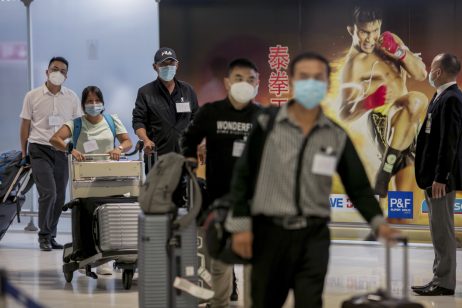The arrival of the first Chinese tourists in Thailand under the Special Tourist Visa program is a good sign for the Thai economy.
Economic development in Thailand has been significantly damaged amid the pandemic due to the shrinking tourism and business travel sector. In Phuket, the country’s second most popular destination for international tourists after Bangkok, for example, bars have been empty; streets, restaurants and beaches have been deserted; and almost 3,000 hotels have closed.
Thailand’s tourism and economy have in recent years increasingly depended on the inflow of Chinese tourists. Broadly speaking, tourism, including domestic tourism, exceeds 10 percent of GDP in nearly half of the Asian Development Bank (ADB)’s member countries, including Thailand. In developing Asia, Chinese visitors comprise a sizable share of all tourists. The number of outbound tourists from China grew eightfold from less than 11 million in 2003 to almost 87 million in 2018. Chinese visitors account for more than 25 percent of all tourists in each of Thailand, Myanmar, and Vietnam, among other Asian countries.
After the outbreak of the pandemic, the number of foreign tourists, including those from China, decreased, leading to the shrinking of the tourism industry in Thailand and wider developing Asia. According to World Tourism Organization (WTO), Thailand ranked ninth in international tourism recipients by percentage of GDP in 2017, when international tourism comprised some 13 percent of the national GDP. ADB staff estimated that the decline in tourism revenues from Chinese nationals alone between 0.8 percent and 2.4 percent of Thailand’s GDP from January to February 2020, and that was just the very early stage of the present pandemic.
Fortunately, Thailand has only recorded a handful of domestic confirmed cases since June. And China’s local outbreaks have swiftly dissipated after Chinese authorities proactively tested entire cities where outbreaks occurred and have quarantined individuals who have been in contact with COVID-19 patients. As a result, Thailand and China co-introduced the Special Tourist Visa program, allowing a small number of Chinese nationals to visit Thailand. Thirty-nine Chinese visitors flew from Shanghai to Bangkok on October 20, the first such arrivals since international tourism was banned earlier in 2020. They were required to comply with a 14-day quarantine rule. If everything goes as planned and no local outbreaks occur in Thailand as a result of the trickle of Chinese tourists, it’s expected that a greater flow will be welcomed — helping restore the Thai economy.
Last year, Thailand welcomed almost 40 million foreign visitors. Such great numbers are unlikely before a reliable vaccine is available and in wide global use. In the meantime, Thai businesses, especially those relying on international tourists as major revenue sources, will continue to feel pressure. That being said, Thailand welcoming Chinese tourists within a strict regime including quarantine requirements nevertheless will benefit Thailand. If outbreaks occur, Thai authorities might need to halt the Special Tourist Visa program intermittently. As long as Thai authorities cautiously enable the inflow of Chinese tourists, more local businesses, especially those located in major tourist destinations, can better restart their operations.




